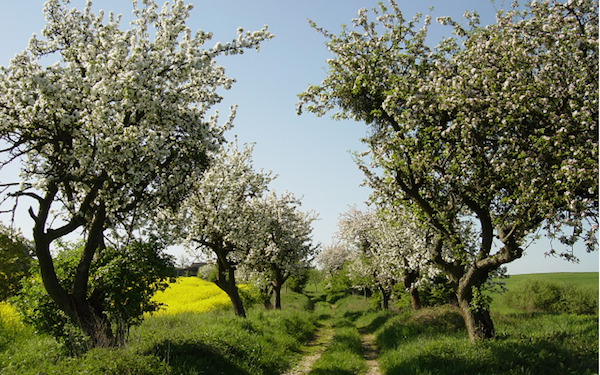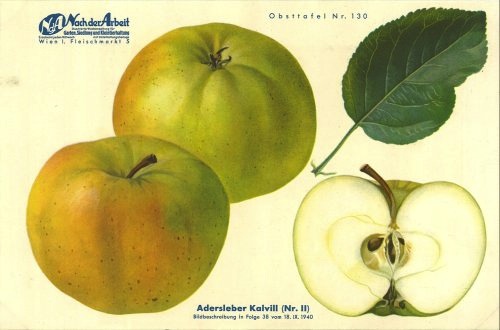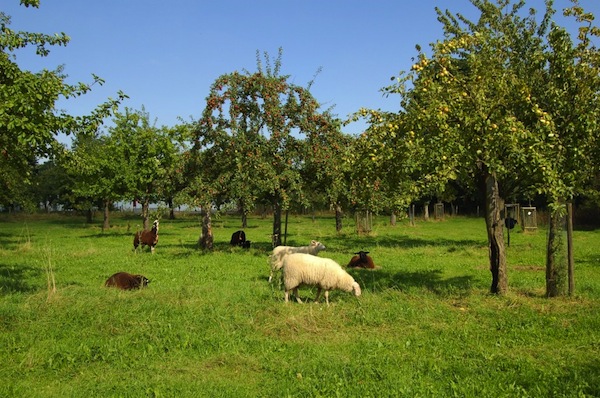It’s autumn, and I’m talking with Anja Fiedler about apples. She harvested over 10,5 tons, this year from public lands in the Berlin region with and for city families and school children as part of her Project “ Apfelschätze” organized by her initiative “Stadt macht saat” which teaches young, people how to look for edible food in their environment.
I’m curious how you got involved with Statt macht saat and also with apples?
I started to get interested in apples 9 years ago. My husband has a little cottage in the Uckermark and every year I saw that there were only 2 apple trees harvested in the whole in the village. In January, I saw all the rest of the red apples fallen down in the snow. It was really terrible, I thought there were about 40 tons in this old village. And I always thought at this time I wanted to bring young people to harvest apples to bring to old people’s homes and make marmalade together and call it ‘jam session’. But to organize it was always a big deal. Then I started Statt macht saat and I thought : this apple project is now or never. And so we did it. In 2012 we harvested over 3,5 Tonnes and made 1000 Ltr. of apple juice.

Are the trees on public land or private?
It’s public land, an alley actually. I asked the community, and they said we could take the apples. The trees are uncared for and they didn’t even know what apples they had. The woman who is in charge of all trees has little knowledge about them. They really don’t treasure what they have. So I went with a Pomologist, an apple expert to asses the trees.
How old do you think the trees are?
Very old. The oldest are about 80- 100 years. The (quality of) fruit depends on this and sometimes the branches on the trees are broken. But even old, uncared-for trees are still very good. Normally you get smaller fruit and sometimes they get spots or different skin blemishes. You can also find very rare and expensive apples. There is an apple that people buy for up to 6 Euros a kilo. It’s called Adersleber Kalvill.

Why do you think this particular apple is so expensive?
It’s really delicious. It’s really one of the best apples I’ve ever had. It’s very mild and looks unspecial. Only my husband harvested them, everyone else passed them by. It’s green and quite small and really not very pretty. At first you bite in it and it’s not special but then it’s really an explosion of taste.
Is it a German variety?
Yes, from Central Europe and has been cultivated since the early 19th century. Also, what was very interesting for me is to imagine how this public apple alley used to feed the village . You have little summer apples, more fall apples and a lot of winter/storage apples. The Pomologist could read from trees varieties the apple trends of the last century: In the 30’s, they liked English varieties. And 40’s were the American apples.
So how many different kinds of apples do you think there are in this alley?
Maybe 30-35 (in the region) on the alley 15- to 20.
Is that unusual?
The Pomologist told me that normally there are even more varieties in one region and it shows that here was a poor area.
Do you think in GDR times, there was more care for the trees?
I think (all the trees) were all accounted for and the people hired someone to take care of them. Now they have all come back to the community. We met an old man in the village who was around 90 and he remembers these apple trees from his childhood. At that time, two or three people were living off these trees and not one apple was missed.
That’s really interesting.
There was a big difference in West Germany. I think in the 50’s they were looking into special international varieties and the government gave farmers lots of money to take out the old trees and change to more modern and boring contemporary varieties to increase production.
I see ‘Streuobst’ everywhere. Can you explain what Streuobst is? Is it typical German?
It is a traditional way of fruit growing in this part of Europe. On a Streuobst field (Streuobstwiesen) a variety of fruit trees of many ages are allowed to grow very high. Some of the fruit alleys and Streuobstwiesen are on common land, called Allmende. Most villages built one fruit orchard together with lots of different varieties and not just apples, but also plums and pears and all kinds of tree fruit. They had a special system of taking care of it and all the harvest was shared throughout the year. It was part of self-sufficiency and common agriculture.
Was that everywhere in Germany?
Yes.
What does it mean when I see Streuobst fruit or juice today in the store?
It means that there are all mixed varieties and probably grown without chemicals. I think what is very important is that the Streuobstwiese is also a refugee for different animals. The variety of plants supports different kinds of wild life and the biodiversity of animals.

Why do you think it’s so hard for the cities to imagine fruit in the city? You’re telling me orchards have been part of the village concept for a long time, its German history and also part of the regional identity. So then, why do you think the concept to bring fruit trees into the city (Berlin) is so radical? And it must be said that Berlin is not the most urban city in Germany.
I think it would be so easy to do nuts and fruit trees to cover a lot of the supply for the city. At least some would be very easy. I think it’s a lot of work especially when the apples fall down. The fear of the city enforcement is more work. Enforced work is not very popular. I have just found out that the city regulations do not allow trees with edible crops. You would have to change the regulations. (See my new project Stadt Baum Schule.) If you notice urban trees, they are mostly very banal varieties like Linden and Plantan. I learned recently that there are certain varieties bred just for cities that are designed without fruit and also so the leaves fall all at the same time.
Like the Gingko. I ‘ve noticed here in the city is that there is some attention to foraging a few specific trees like the Elder tree in the spring for the flowers, but not as much in the fall for the berries. There are also a lot of rose hips everywhere that no one touches.
Yes also the Ebereschhe, It’s a small common red fruit that the birds eat. They are everywhere in wintertime. Children learn that it is poison but in fact it is very, very healthy and rich of vitamin C. And it is very bitter , so no one will eat enough to get poisoned. You can also make marmalade or dry them. It’s an easy growing tree, which is why a lot of cities use it.
So you are working with Children. How do you teach them what is safe to be harvested in the city?
I think it’s really interesting to work with children; maybe they are easier than adults to work with because the adults already have a stigma against eating urban foraged food and have to be re-trained.
Often in Berlin, I hear adults fear food foraged in the city because of air pollution. Which was a concern in Berlin in the 80’s and earlier, but now it is vastly improved. So how to do retrain people? I think this is an important aspect of your work.
I think one key is to get people to harvest from their surroundings. I’ve really tried to find places in neighborhoods. I also like to suggest that a tree that (someone) passes by each day can become a friend. And so you can observe and get to know it throughout the year, and in May you recognize that it’s time to harvest the Elderflower for example. I also only harvest far away from the streets. We go to cemetery or parks or hidden places. Studies from the Technical University show, that if you follow some rules, the quality of foraged food is very high and the pollution little. In a short time people see their surroundings with new eyes. Also, now it is true for me, when I walk down the street I always see edible things. It’s really fascinating for kids to see the streets in different perspective. I think this is really cool and they feel good that they know something special. Often they will try something for the first time like Elderflowers.
Which are everywhere in Berlin. What’s your favorite Elderflower recipe?
You take only the leaves of the flower, the petals. And you fill an entire glass and put wine vinegar over it. And let it sit for a few weeks. Then it is fantastic pickles, that can be stored for months up to two years. It´s great, so you can eat the flowers the whole year.
What do you think of this idea of foraging in the city? I’m sure you’ve noticed how popular it is now. Like for example foraging for herbs in the city, mushrooms, or from the trees, or the idea of urban permaculture.
I think it’s really interesting and it’s great that there are so many different people doing it. I am working in a really different direction in my project “Stadt macht saat”. I have a big filter in order to reach people, that have not a lot of time; They need a good result and a success feeling. I think I reach the people who would never do it and children. I need to make it really simple. I am not an expert in this area, but I think you have to know quite well where to harvest for pollution and to stay away from dog waste. I think a lot of what you are harvesting in the city is usually better than pesticide foods that you buy in the supermarket, so you shouldn’t be so afraid to eat from the city, but never the less, I think you need to have the knowledge or a conscience of what and where you take and what you mustn’t take. The people I work with and the pupils, it’s really just a teaser. We harvest really simple things like apples.
Apples are really the perfect fruit.
Yes, apples are the perfect teaser fruit. But I try to teach also with different plants, like Elderflower, nuts, and little plums. You can find them easily around the city-in parks and other spots, so you can recommend to people to look themselves.
But apple really can tell so much about our global industrial food economy. We have estimated 1,500- 5,000 apple varieties in Germany from about 20,000 world-wide. In the global industrial production and in our supermarkets we only find 5-10 varieties.
All of these commercialized varieties, I find disturbing. The idea that the ‘perfect apple’ has set characteristics like- crunchy, sweet & juicy. I just learned that they are breeding apples so they don’t turn brown and look beautiful all the time- but it is an empty beauty. All the nutrition is gone. In this research someone asked an expert: Would it be possible to breed a very healthy apple? The expert answered: we already have this, the old apples are our health bombs. But in the global industrial production the varieties are chosen not for their nutrition but for their size, the way they look, their profitability and ease of transportation. In the 80’s apples were bred to be one color; green, red or yellow and now two colors are more popular. Another trend today is that commercial apples are large in size. Too big for many people in fact. In the Kindergarten they eat one bite and throw the rest away.
What a pity! That’s why Anja’s work is so important. She can inspire a whole new generation of urban tastebuds to determine what a perfect fruit is for themselves.